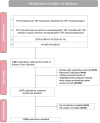Paradigm shifts in neonatal hypoxic-ischemic encephalopathy therapeutics: a four-decade bibliometric exploration of emerging therapeutic dimensions (1985-2024)
- PMID: 40791807
- PMCID: PMC12336269
- DOI: 10.3389/fped.2025.1611345
Paradigm shifts in neonatal hypoxic-ischemic encephalopathy therapeutics: a four-decade bibliometric exploration of emerging therapeutic dimensions (1985-2024)
Abstract
Aim: Neonatal hypoxic-ischemic encephalopathy (HIE) remains a significant cause of neonatal morbidity and mortality worldwide, necessitating the exploration of effective therapeutic interventions. Current treatment strategies primarily involve therapeutic hypothermia (TH); however, its efficacy remains inconsistent. Research topics and trends in this area remain unclear as well. This study aimed to identify key research areas, collaboration networks, and emerging trends using bibliometric analysis tools.
Methods: A comprehensive analysis was conducted on 1,165 records from the Web of Science Core Collection (WoSCC) database. Various bibliometric techniques were employed, including coauthor analysis, co-occurrence analysis, co-citation analysis, reference clustering, and topic modeling, to visualize the knowledge structure and research dynamics in the HIE field.
Results: The findings revealed extensive collaboration networks among authors, institutions, and countries, highlighting global efforts to address this critical neonatal condition. Recent trends identified key research areas, including TH, mild systemic hypothermia, oxidative stress, biomarkers and signaling pathways, which are essential for advancing the understanding and treatment of HIE.
Conclusion: This study provides valuable insights into the current TH for neonates with HIE. Future research should focus on optimizing treatment approaches and evaluating long-term efficacy to enhance clinical applications.
Keywords: bibliometric analysis; biomarkers; emerging treatments; hypoxic-ischemic encephalopathy; signaling pathways; therapeutic hypothermia.
© 2025 Shu, Liu, Yuan, Ma and Yang.
Conflict of interest statement
The authors declare that the research was conducted in the absence of any commercial or financial relationships that could be construed as a potential conflict of interest.
Figures







References
Publication types
LinkOut - more resources
Full Text Sources

